
Thursday, February 2, 2012
Sunday, January 29, 2012
Friday, January 27, 2012
Figs in space
Canadian high school students Mathew Ho and Asad Muhammad had an idea. They'd seen that some MIT students had sent a balloon into space, and they wanted to try it themselves. The purchased a balloon, and created a payload that involved cameras, a video camera, and a smart phone with GPS tracking. They sent this up about 80,000 feet about the earth's surface, and were able to take amazing photos. What's more, they were able to retrieve the payload and get this data. The reason it's hitting this blog is that they had a passenger. Watch the video to see an accelerated view of a minifig going where no fig has gone before (well, there are actually some LEGO pieces on the International Space Station, and images of figs were on a Mars probe).


Friday, January 20, 2012
Google Science Fair
Google is once again sponsoring an international science fair. If you're a teenager, check it out. The sponsors are Google, CERN, National Geographic, Scientific American, and ... LEGO!

Here are last year's winners Lauren Hodge, Shree Bose, and Naomi Shah as the guests of President Obama. Note the cool LEGO trophies!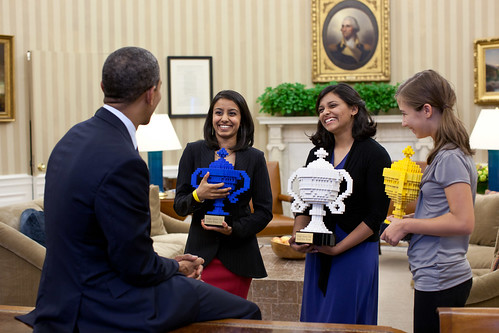

Here are last year's winners Lauren Hodge, Shree Bose, and Naomi Shah as the guests of President Obama. Note the cool LEGO trophies!

Sunday, January 15, 2012
Anatomy
Nannan Zhang is in med school, and he made this tribute to his Anatomy professors, the UTSW Anatomists.


Saturday, January 14, 2012
Friday, January 13, 2012
... in a galaxy not so far, far away ...
Astronomers using the Kepler space telescope have found a third real-lifeTatooine (here in LEGO by Larry Lars). No, they haven't seen Jawas running around. Instead they've found another planet circling a binary star. Though this was a gas giant, it was very near the habitable zone of the binary system. Scientists estimate there might be several million of these in the Milky Way, suggesting that there might be somewhere within a few hundred light years you could go out and watch the double sunset.


Thursday, January 12, 2012
Saturn V
Check out this amazing detailed and massive Saturn V by LEGO Professional Ryan McNaught. This is surely the MOC by which we will judge all future NASA MOCs. You can read some details in this article. BTW, if you're down under, get yourself to Melbourne next week for the Brickvention gathering, where you'll be able to see this in person.

Oh, can I say it again, this is massive. 5.6 meters tall, to be precise. That makes it, I believe, true to minifig scale. See here with Ryan for scale:


Oh, can I say it again, this is massive. 5.6 meters tall, to be precise. That makes it, I believe, true to minifig scale. See here with Ryan for scale:

Tuesday, January 10, 2012
Galapagos Tortoise
The Galapagos tortoise played a role in Darwin's development of the theory of evolution. He realized that the tortoises on different islands had developed differently in response to their environment, writing "animals on separate islands ought to become different if kept long enough apart with slightly differing circumstances. – Now Galapagos Tortoises, Mocking birds, Falkland Fox, Chiloe fox, – Inglish and Irish Hare."
The news reported yesterday that a species of Galapagos tortoise previously thought to be extinct is still alive. Biologists found genetic markers unique to that species in living tortoises that appear to be cross-breeds.
Here Kaptain Kobold depicts Darwin observing a tortoise.

The news reported yesterday that a species of Galapagos tortoise previously thought to be extinct is still alive. Biologists found genetic markers unique to that species in living tortoises that appear to be cross-breeds.
Here Kaptain Kobold depicts Darwin observing a tortoise.

Sunday, January 1, 2012
Boom
We all recognize a mushroom cloud (here in LEGO by Brucey-Wan) as the result of an atomic explosion. A radioactive element is one that is unstable due to the ratio of protons and neutrons in the nucleus. These atoms fall apart, often emitting small subatomic particles. If you have a high enough concentration of unstable atoms (i.e. critical mass), these subatomic particles can ram into other radioactive nuclei, causing them to break apart just like hitting the cue ball into a rack of balls at the start of a game of pool. This breakdown (fission) leads to more subatomic particles being spit out, which run into more nuclei, and again and again and again, a chain reaction. At each fission event a small amount of energy is given off, but as the chain reaction proceeds, a huge number of atoms break down in a very small time, and the huge amount of energy given off is the atomic explosion. This energy superheats the air, which expands with explosive force as the blast. At the center of the blast, this hot expanding air rises straight up, and this creates a wind coming in and up that pulls up dust and debris from the ground. When this reaches a high enough elevation, hitting much cooler air, the cloud stops rising and mushrooms outward. This cloud also contains radioactive elements blown apart in the initial atomic blast, and this dust settling back to earth is the radioactive fallout.
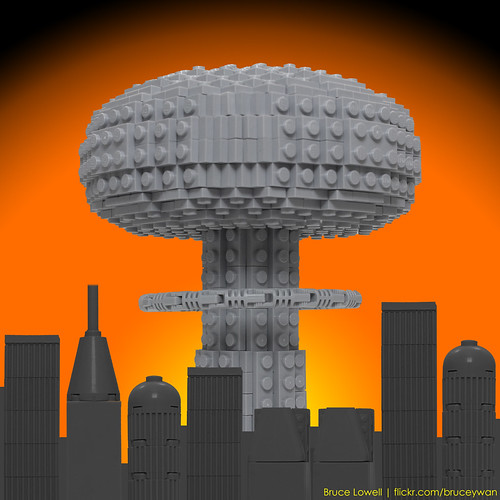

Sunday, December 25, 2011
Merry Christmas
Physicist Kenneth Libbrecht of Caltech is fascinated by snowflakes (here in LEGO by lego_mancer). Snow crystals (flakes are technically blobs of conglomerated snow crystals) form when a tiny droplet of water freezes in a cloud at about -10 degrees C. The initial ice crystal will form a hexagonal prism due to the symmetry of how water molecules interact. After the first solid crystal forms, supercooled water vapor will go directly from the vapor to solid phase, starting at the six corners of the prism. As the crystal tumbles through the cloud, water condenses faster and slower, giving the beautiful complex shapes we've all known since we cut snowflakes out of paper in a grade school art class.
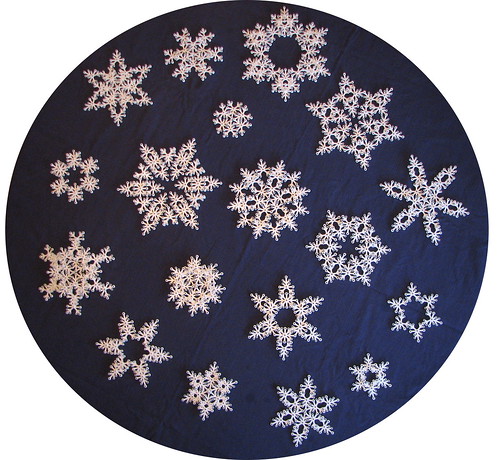
Learn much more at his site SnowCrystals.com. This site is very well written for the non-scientist, and you can learn things about the reason for the hexagonal shape, why snow looks white, whether any two crystals are actually the same, and how to grow artificial snow crystals. There are also tons of beautiful photos. Give yourself a Christmas treat and check out the site.

Learn much more at his site SnowCrystals.com. This site is very well written for the non-scientist, and you can learn things about the reason for the hexagonal shape, why snow looks white, whether any two crystals are actually the same, and how to grow artificial snow crystals. There are also tons of beautiful photos. Give yourself a Christmas treat and check out the site.
Saturday, December 24, 2011
LEGO for girls / science for girls
As a science educator, we constantly hear about the pipeline. The education pipeline starts with a perfect balance between boys and girls, but over the years from grade school to high school to college to graduate school girls get turned away from STEM (science, technology, engineering and mathematics) disciplines at a greater rate than boys. The numbers are certainly significantly better than they were ten or twenty years ago, but there is still a disparity between men and women in technical fields.
Okay, I know that I'm biased here since I'm obviously a LEGO fan, but I believe that playing with LEGO as a kid can be a great learning tool. Kids learn problem solving skills, they follow directions, they learn three dimensional thinking. I contend that I'm an organic chemist today in part because of playing with those little plastic bricks in my childhood. While LEGO bricks are gender neutral, LEGO has become known to many as a "boys' toy". Now LEGO is working to turn this around with the new Friends line. They've studied how girls play similarly to and differently from boys. The figures are meant to look more like girls than the traditional minifig, since they argue that girls want toys that look like themselves. The main characters have story lines, similar to the American girls series (though without the historical tie in, that might have been cool), and the color palette is supposed to be more 'girl-friendly'.
This move has not been without some controversy. As I see it, the complaints come in a couple of flavors. Some within the fold of LEGO builders don't like the new figs and the move away from more open ended non-story-driven building. Others argue that these sets play into too many gender stereotypes. 'Boy' sets are about exploring and conquering, while the new 'girl' sets (which are all pink and lavender) have girls going to the hair salon. I certainly understand both of these points. However, as the dad of a four-year-old girl, I'm pretty excited about these sets. Like it or not, my girl is totally into princesses and fairy tales, and I don't think (maybe I'm fooling myself here) that we've tried to indoctrinate her into some stereotype roles here. But she'll completely love these set. The new figures, for instance, are extremely similar to some Strawberry Shortcake figures she already has and loves. And loving these sets will, I'm sure, push her to more inventive building with LEGO, and all of the educational benefits that go along with that. (To be fair, she also completely loves her Toy Story LEGO sets, and those are completely gender neutral.)
Don't worry, though. I'm not going to run out and buy her the hair salon set. The first one that I'll get will be Olivia's inventor's workshop (okay, probably the puppy set too). Check this out! Here we have a girl playing with a microscope, building a robot, and working out mathematical equations on a chalkboard. Now that's the sort of role model I want for my girl. I hope that LEGO makes more sets along these lines as they expand the Friends theme. But even if they don't, I think that getting more girls into building with LEGO is a Good Thing, both as a LEGO enthusiast and as a science educator.

Okay, I know that I'm biased here since I'm obviously a LEGO fan, but I believe that playing with LEGO as a kid can be a great learning tool. Kids learn problem solving skills, they follow directions, they learn three dimensional thinking. I contend that I'm an organic chemist today in part because of playing with those little plastic bricks in my childhood. While LEGO bricks are gender neutral, LEGO has become known to many as a "boys' toy". Now LEGO is working to turn this around with the new Friends line. They've studied how girls play similarly to and differently from boys. The figures are meant to look more like girls than the traditional minifig, since they argue that girls want toys that look like themselves. The main characters have story lines, similar to the American girls series (though without the historical tie in, that might have been cool), and the color palette is supposed to be more 'girl-friendly'.
This move has not been without some controversy. As I see it, the complaints come in a couple of flavors. Some within the fold of LEGO builders don't like the new figs and the move away from more open ended non-story-driven building. Others argue that these sets play into too many gender stereotypes. 'Boy' sets are about exploring and conquering, while the new 'girl' sets (which are all pink and lavender) have girls going to the hair salon. I certainly understand both of these points. However, as the dad of a four-year-old girl, I'm pretty excited about these sets. Like it or not, my girl is totally into princesses and fairy tales, and I don't think (maybe I'm fooling myself here) that we've tried to indoctrinate her into some stereotype roles here. But she'll completely love these set. The new figures, for instance, are extremely similar to some Strawberry Shortcake figures she already has and loves. And loving these sets will, I'm sure, push her to more inventive building with LEGO, and all of the educational benefits that go along with that. (To be fair, she also completely loves her Toy Story LEGO sets, and those are completely gender neutral.)
Don't worry, though. I'm not going to run out and buy her the hair salon set. The first one that I'll get will be Olivia's inventor's workshop (okay, probably the puppy set too). Check this out! Here we have a girl playing with a microscope, building a robot, and working out mathematical equations on a chalkboard. Now that's the sort of role model I want for my girl. I hope that LEGO makes more sets along these lines as they expand the Friends theme. But even if they don't, I think that getting more girls into building with LEGO is a Good Thing, both as a LEGO enthusiast and as a science educator.

Tuesday, December 20, 2011
Saturday, December 17, 2011
PhD!!
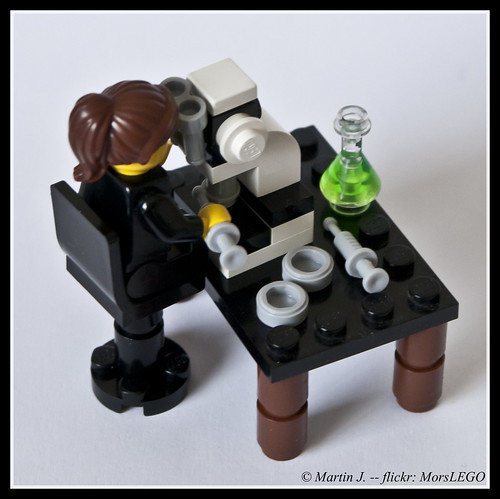
Congratulations to MorsLEGO's wife, who just completed her PhD in Cellular and Molecular Biology. He made her this small scene of her at her microscope in commemoration of her achievement.
Thursday, December 15, 2011
Roald Amundsen
I missed posting this yesterday, which was the 100th anniversary of Roald Amundsen (here by BruceWaynelego) reaching the South Pole.


Tuesday, December 13, 2011
Higgs boson
CERN scientists in Geneva today reported that they may have found evidence for the Higgs boson, a fundamental particle in the universe that was predicted by the standard model and is thought to play a role in why all of the other particles have mass. The Large Hadron Collider smashes protons together at extremely high speeds and then analyzes the debris. One of the instruments used to study the pieces is the Atlas detector, here in LEGO form by Dr. Sascha Hehlhase. Dr. Hehlhase is a physicist at the Niels Bohr Institute in Denmark. This model is scaled to a minifig, which gives you a feel for the size of the real thing.


Monday, December 12, 2011
Happy Integrated Circuit Day
I'm sure I'm not the only one here who start their online day with Google as their homepage. Anyway, today's Google doodle honors Robert Noyce, who, along with Jack Kilby, invented the integrated circuit (here much larger, in ABS rather than silicon, by Dave and John Xandegar). Over the past half century, our whole world has been turned upside down by the technology flowing from their initial work.


Tuesday, December 6, 2011
Farewell, Voyager
If you're my age, and in any way interested in science, you probably remember being inspired by all of the great images of Jupiter and Saturn that came out when I was in about fifth or sixth grade as the Voyager 1 and Voyager 2 probes flew past our Solar System's biggest planets. You may even remember watching Carl Sagan tell us all about them on TV. Anyway, Voyager 1 (here in LEGO form by Shane Larson) is at the very edge of the Solar System. At about 11 billion miles away from the Sun, the probe has entered a region where the effect of the solar wind, energy and particles being pushed out from our sun, is all but gone, and it is starting to feel the currents of interstellar space. The batteries will last until the year 2025, so as the probe goes further, scientists are looking forward to learning more about what it's really like out there beyond the edge of our chunk of the galaxy.


Friday, December 2, 2011
Gagarin
Lego Monster Ed Diment and members of the Brickish Association helped coordinate a massive group build where members of the public put together this mosaic at the Lego Space show at the National Space Centre Leicester, UK, this past July.
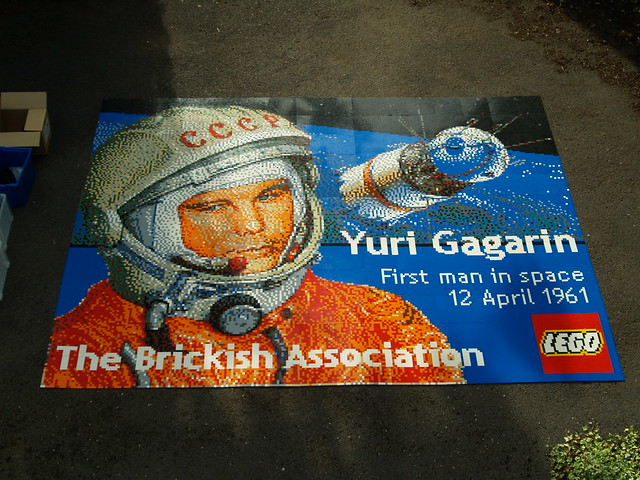

Sunday, November 27, 2011
Lemniscate
The lemniscate of Bernoulli, here by aklego, is a plane curve defined from two given points F1 and F2, known as foci, at distance 2a from each other as the locus of points P so that PF1·PF2 = a2. This is a special case of a Cassini oval (which is simply where the product of the two distances equals a constant).
BTW, all of that description came straight from Wikipedia. It's been a lot of years since I took a formal math class, and don't remember these at all.
BTW, all of that description came straight from Wikipedia. It's been a lot of years since I took a formal math class, and don't remember these at all.
Subscribe to:
Posts (Atom)


